Formal specification and verification
Formal specification and verification
Frédéric Herbreteau, Bordeaux INP/LaBRI (frederic.herbreteau@bordeaux-inp.fr)
Objective
- Use model-checking to assert the correctness of a system
- from a model $M$: a set of runs given as a transition system
- and a specification $\varphi$ \(M \models \varphi\)
- The specification $\varphi$ shall specify which runs are correct and which are not
- A dedicated algorithm is then use to decide wether $M \models \varphi$ or not
What is a specification?
- Property of the runs of a system: which runs are correct and which are not?
- Must have a clear and well-defined semantics
Example: mutual exclusion
”$\textcolor{blue}{P_1}$ and $\textcolor{red}{P_2}$ do not access the critical section simultaneously”

Formalising specifications
- $AP$ = set of atomic propositions on states (labels)
- $\Sigma = 2^{AP}$ is the set of all sets of atomic propositions (observations)
- $\Sigma^*$ and $\Sigma^\omega$ are the sets finite and infinite sequences over $\Sigma$
- A property $P$ is any subset of infinite traces from $\Sigma^\omega$
Example: mutual exclusion (cf. previous slide)
- $AP$?
- What is $\Sigma$?
- Give some traces from $\Sigma^*$ From $\Sigma^\omega$?
- Express “$\textcolor{blue}{P_1}$ and $\textcolor{red}{P_2}$ do not access the critical section simultaneously”
Invariance properties
- Properties that involve only one state (not a sequence of states)
- Must hold in every state of the model
Example:
- mutual exclusion: no state with both $\textcolor{blue}{cs_1}$ and $\textcolor{red}{cs_2}$
- absence of deadlock: every state has (at least) one outgoing edge
- domain: the value of $x$ is always non-negative
Algorithmic verification of invariance properties
Exercise: Give an algorithm to check an invariance property over a finite transition system
- Invariant property in TLA+:
Mutex == ~(cs1 /\ cs2) (* in .tla file *)
INVARIANT Mutex \* in .cfg file
- Deadlock verification in TLA+:
CHECK_DEADLOCK TRUE \* in .cfg file
Temporal Logic (TL)
Temporal properties
- Temporal refers to logical time
- Temporal properties express requirements over infinite sequences of states
Example:
- “Accesses to the critical section are alternatively granted to $\textcolor{blue}{P_1}$ and $\textcolor{red}{P_2}$”
- “If $\textcolor{blue}{P_1}$ requests the critical section, then access is eventually granted”
- A temporal property is true for a model if all its runs satisfy the property
- Two kinds of temporal properties: safety and liveness
Safety properties
“Nothing bad will never happen”
Example:
- Invariant properties are a special case of safety properties
- Partial correcteness for sequential programs
- ”$\textcolor{blue}{P_1}$ and $\textcolor{red}{P_2}$ do not access the critical section simultaneously”
- “Accesses to the critical section are alternatively granted to $\textcolor{blue}{P_1}$ and $\textcolor{red}{P_2}$”
A safety property is characterised by a set $B \subseteq \Sigma^*$ of finite counter-examples
Definition A set $P \subseteq \Sigma^\omega$ is a safety property if there exists $B \subseteq \Sigma^*$ such that $P = \Sigma^\omega - (B \Sigma^\omega)$
Liveness properties
“Something good will eventually happen”
Example:
- Termination for sequential program
- “Each process will eventually enter the critical section”
- “If $\textcolor{blue}{P_1}$ requests the critical section, then access is enventually granted”
- “Processes enter the critical section infinitely often”
A liveness property is characterised by infinite counter-examples.
Definition: $P \subseteq \Sigma^\omega$ is a liveness property if every finite sequence can be extended into an infinite sequence in $P$
Example: mutual exclusion
Safety: “nothing bad never happens” Liveness: “something good eventually happens”
Example: Processes compete to access their critical sections protected by a lock.
Safety of liveness?
- Two processes never access their critical section at the same time
- Each process accesses the critical section infinitely often
- If a process requires access to the critical section, access is eventually granted
- The lock is never stolen
Decomposition of specifications
Decomposition lemma: For every property $P \subseteq \Sigma^\omega$, there exists a safety property $S$ and a liveness property $L$ such that $P = S \cap L$.
Proof: let $Closure(P)$ be the set of words $w \in \Sigma^\omega$ s.t. all their prefixes are prefixes of words in $P$. Then, choose $S = Closure(P)$ and $L = P \cup (\Sigma^\omega - Closure(P))$
Exercise: which properties are safety and liveness at the same time?
- Specifications mix safety, to ensure good behavior, and liveness, to ensure progress
- For sequential programs: correctness (w.r.t. precondition and postcondition) and termination
Temporal formulas
| $\varphi ::= p \, | \, \lnot \varphi \, | \, \varphi \land \varphi \, | \varphi \lor \varphi \, | \, \varphi \implies \varphi \, | \, \Box \varphi \, | \, \Diamond \varphi \qquad\qquad \text{with } p \in AP$ |
- $\Box$ means “always”
- $\Diamond$ means “eventually”
Example:
- $\Box \lnot (\textcolor{blue}{cs_1} \land \textcolor{red}{cs_2})$
- $\Diamond \textcolor{blue}{cs_1} \land \Diamond \textcolor{red}{cs_2}$
- $\Box (\textcolor{blue}{req_1} \implies \Diamond \textcolor{blue}{cs_1})$
TLA+ operators: ~, /\, \/, =>, [], <>
Semantics of temporal formulas
Expressed over infinite sequences of observations (sets of labels):
Example: labels ${\textcolor{blue}{cs_1}$, $\textcolor{red}{cs_2}}$ trace: {} {} {$\textcolor{blue}{cs_1}$} {} {$\textcolor{red}{cs_2}$} {} {} … {} {$\textcolor{red}{cs_2}$} {} {$\textcolor{blue}{cs_1}$} {} {} {$\textcolor{blue}{cs_1}$, $\textcolor{red}{cs_2}$} {} {} …
$\sigma$ an infinite trace, $\sigma[i]$ its value in $i$, $\sigma[i…]$ its suffix from $i$
- $\sigma \models p$ if $p \in \sigma[1]$
- $\sigma \models \lnot \varphi$ if $\sigma \not\models \varphi$
- $\sigma \models \varphi_1 \land \varphi_2$ if $\sigma \models \varphi_1$ and $\sigma \models \varphi_2$
- $\sigma \models \Box \varphi$ if $\sigma[i…] \models \varphi$ for every $i \ge 1$
- $\sigma \models \Diamond \varphi$ if there exists $i \ge 1$ such that $\sigma[i…] \models \varphi$
Illustration
Example: Labels: ${\textcolor{blue}{req_1}, \textcolor{blue}{cs_1}, \textcolor{red}{cs_2}}$
Traces:
- $\sigma_1$: {} {} {$\textcolor{blue}{cs_1}$} {} {$\textcolor{red}{cs_2}$} {} {} … {} {$\textcolor{red}{cs_2}$} {} {$\textcolor{blue}{cs_1}$} {} {} {$\textcolor{blue}{cs_1}$, $\textcolor{red}{cs_2}$} {} {} …
- $\sigma_2$: {} {$\textcolor{blue}{cs_1}$} {} {} {$\textcolor{red}{cs_2}$} {$\textcolor{blue}{req_1}$} {} {} {} {$\textcolor{blue}{cs_1}$} {} … {} {$\textcolor{blue}{req_1}$} {} {$\textcolor{red}{cs_2}$} {} {} {} {} …
Are the formulas below satisfied or not by the traces above?
- $\Box \lnot (\textcolor{blue}{cs_1} \land \textcolor{red}{cs_2})$
- $\Diamond \textcolor{blue}{cs_1} \land \Diamond \textcolor{red}{cs_2}$
- $\Box (\textcolor{blue}{req_1} \implies \Diamond \textcolor{blue}{cs_1})$
Combining operators
- $\Box\Diamond$ “infinitely often”
- $\Diamond\Box$ “almost always”
- $\rightsquigarrow$ “leads-to” (
~>in TLA+): $\varphi_1 \rightsquigarrow \varphi_2$ is a shortcut for $\varphi_1 \implies \Diamond \varphi_2$
Example: Write traces that satisfy the formulas below, and traces that falsify them:
- $\Box\Diamond \textcolor{blue}{cs_1}$
- $\Diamond\Box \textcolor{blue}{req_1}$
- $\textcolor{blue}{req_1} \rightsquigarrow \textcolor{blue}{cs_1}$
- $\Box (\textcolor{blue}{req_1} \rightsquigarrow \textcolor{blue}{cs_1})$
Relation between $\Box$ and $\Diamond$
Exercise: Give traces that are respectively satisfied by $\Box p$, $\Box \lnot p$, $\lnot \Box p$, $\Diamond p$, $\Diamond \neg p$, $\neg \Diamond p$
- What is the difference between $\Box \lnot p$ and $\lnot \Box p$?
- What is the difference between $\Diamond \lnot p$ and $\lnot \Diamond p$?
- What is the relation between $\Box$ and $\Diamond$?
Semantics over a transition system
Definition A transition system $M$ satisfies a temporal formula $\varphi$ ($M \models \varphi$) if $\sigma \models \varphi$ for every infinite trace $\sigma$ from an initial state of $M$.
Example: Which formulas below are satisfied by the model to the right?
- $\Box \lnot (\textcolor{blue}{cs_1} \land \textcolor{red}{cs_2})$
- $\Diamond \textcolor{blue}{cs_1} \land \Diamond \textcolor{red}{cs_2}$
- $\Box (\textcolor{blue}{req_1} \implies \Diamond \textcolor{blue}{cs_1})$
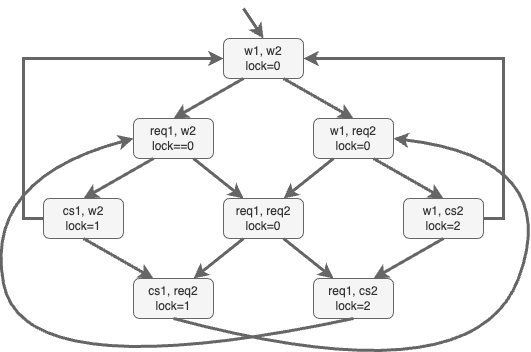
Algorithmic verification of temporal formulas
Goal: given $M$ and $\varphi$, decide whether $M \models \varphi$
Specification in TLA+:
NoStarvation == [](req1 ~> cs1) (* in the .tla file *)
PROPERTY NoStarvation \* in the .tlc file
Algorithm:
- From $\varphi$ compute a Büchi automaton $\mathcal{A}_{\lnot \phi}$
- Compute the product $\mathcal{B} = M \otimes \mathcal{A}_{\lnot \phi}$
- Decide whether $\mathcal{L}(\mathcal{B}) = \emptyset$
From TL formulas to Büchi automata
Example: $\Box \lnot (\textcolor{blue}{cs_1} \land \textcolor{red}{cs_2})$
- {} {$\textcolor{blue}{cs_1}$} {} {} {$\textcolor{red}{cs_2}$} {} {$\textcolor{blue}{cs_1}$} {} {} …
- {} {} {$\textcolor{red}{cs_2}$} {} {$\textcolor{blue}{cs_1}$, $\textcolor{red}{cs_2}$} {} {$\textcolor{blue}{cs_1}$} {} …
Example: $\Box (\textcolor{blue}{req_1} \rightsquigarrow \textcolor{blue}{cs_1})$
- {} {$\textcolor{blue}{req_1}$} {} {} {$\textcolor{blue}{cs_1}$} {} {$\textcolor{blue}{cs_1}$} {} {} {$\textcolor{blue}{req_1}$, $\textcolor{blue}{cs_1}$} {} …
- {} {} {$\textcolor{blue}{req_1}$} {$\textcolor{blue}{cs_1}$} {} {$\textcolor{blue}{req_1}$} {} {} {$\textcolor{blue}{req_1}$} {} {}…
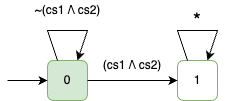
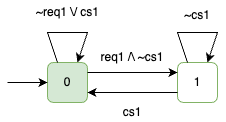
Product $M \otimes \mathcal{A}_{\lnot \varphi}$ (1/2)
Example: $\Box \lnot (\textcolor{blue}{cs_1} \land \textcolor{red}{cs_2})$
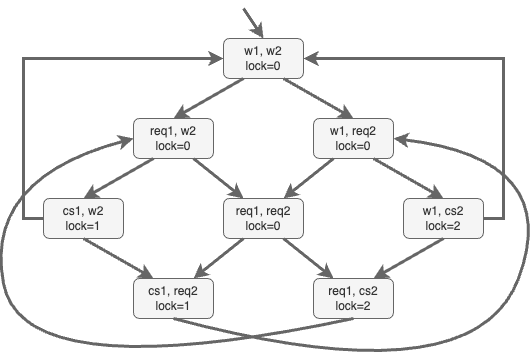
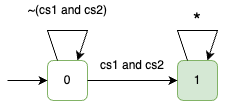
Product $M \otimes \mathcal{A}_{\lnot \varphi}$ (2/2)
Example: $\Box (\textcolor{blue}{req_1} \rightsquigarrow \textcolor{blue}{cs_1})$
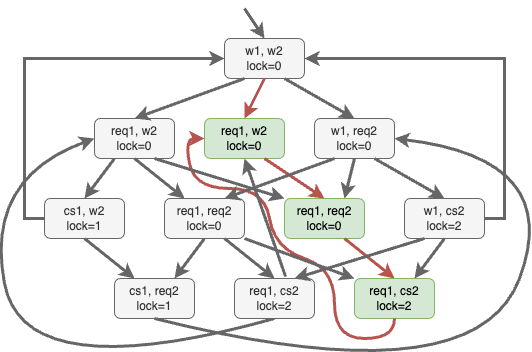
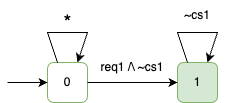
Checking if $\mathcal{L}(M \otimes \mathcal{A}_{\lnot \varphi}) = \emptyset$
- $\mathcal{L}(M \otimes \mathcal{A}_{\lnot \varphi}) \neq \emptyset$ iff there is an infinite run that visits an accepting state infinitely many times
Exercise: give an algorithm that decides if $\mathcal{L}(M \otimes \mathcal{A}_{\lnot \varphi}) \neq \emptyset$
- Overall complexity:
-
TL to Büchi automaton: $ \mathcal{A}_{\lnot \varphi} = 2^{\mathcal{O}( \varphi )}$ -
Product: $ M \otimes \mathcal{A}_{\lnot \varphi} = \mathcal{O}( M \times \mathcal{A}_{\lnot \varphi} )$ -
Emptiness checking: $\mathcal{O}( M \otimes \mathcal{A}_{\lnot \varphi} )$ -
Overall complexity: $\mathcal{O}( M \times 2^{ \varphi })$
-
- NB: the TL model-checking problem is PSPACE-complete
Temporal Logic of Actions
Actions Formulas
- TLA+ allows to specify formulas over actions
Example: “If the lock is not free, then it becomes free in the next state” \((lock \neq 0 \implies lock' = 0)\)
- An action formula $A$ is a formula over primed and unprimed variables, without temporal modalities $\Box$ and $\Diamond$.
- $(s, s’) \models A$ if $A$ holds with values of unprimed variables from $s$ and values of primed variables from $s’$
Temporal formulas with actions
\[\Box [A]_{\langle V \rangle}\]where $A$ is an action formula, $V$ is a tuple of variables
Example: “The lock is never stolen” \(\Box[lock \neq 0 \implies lock' =0]_{\langle lock \rangle}\)
- express properties over consecutive pairs of states on an infinite trace $\sigma$: $\sigma \models \Box [A]_{\langle V \rangle}$ if $(\sigma[i], \sigma[i+1]) \models (A \lor (V’ = V))$ for every $i \ge 1$
- temporal actions formulas are restricted to safety properties over one action
Illustration
Example: \(\Box[lock \neq 0 \implies lock' =0]_{\langle lock \rangle}\)
Does the formula above hold for the traces below (showing the value of $lock$):
- ${0} {0} {0} {0} {0} {0} {0} \dots$
- ${0} {1} {0} {2} {0} {1} {0} \dots$
- ${0} {1} {1} {1} {0} {2} {0} \dots$
- ${0} {1} {1} {1} {1} {1} {1} \dots$
- ${0} {1} {1} {1} {2} {0} {0} \dots$
Stuttering-free formulas
- All TLA+ specificatons should be stuttering free to allow refinement and composition of systems (cf. Stuttering steps)
- TL formulas are stuttering-free, but TLA+ formulas may not be
Example: the formula below should hold for both the abstact and the refined models \(\Box[lock \neq 0 \implies lock' =0]_{\langle lock \rangle}\)
```TLA+ ... req: lock(self); rel: unlock(self); ... ``````TLA+ ... req: lock(self); cs1: y := x; cs2: x := x+1; rel: unlock(self); ... ```
Stuttering-free specifications and PlusCal models
- the TLA+ translation of PlusCal models includes a self-loop on every state
vars == << .... >> \* Tupe of the variables in the model
Init == ... \* Initial states over vars
Next == ... \* Action formula over vars and vars' (transitions)
Spec == Init /\ [][Next]_vars
- this includes a self-loop on the final states (label
Done) - hence every run with no deadlock is infinite (termination = reaching
Done)
Algorithmic verification of temporal formulas with actions
Goal: given $M$ and $\varphi$, decide whether $M \models \varphi$
Specification in TLA+:
LockNotStolen == [][lock # 0 => lock = 0]_<<lock>> (* in the .tla file *)
PROPERTY LockNotStolen z\* in the .tlc file
Algorithm:
- same as for state-based safety properties
- with action properties evaluated on transitions (not on states)
